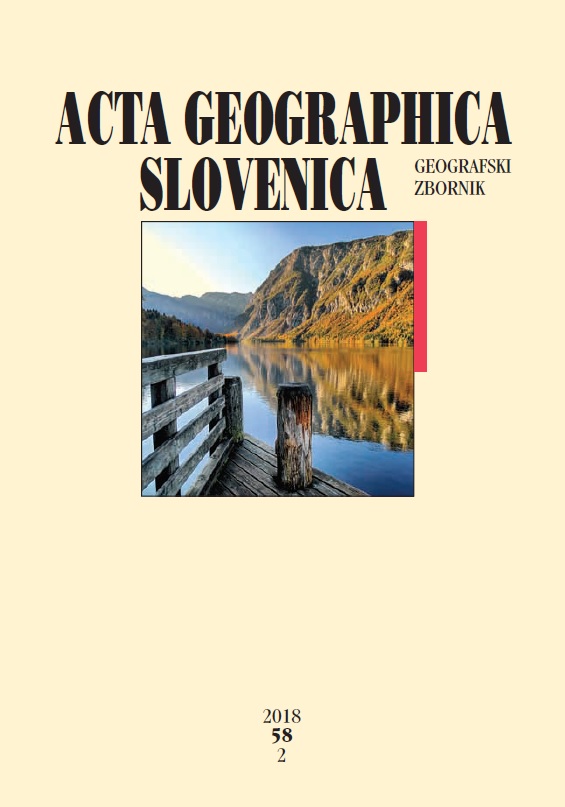Does it really rain more often on weekends than on weekdays? A case study for Slovenia
DOI:
https://doi.org/10.3986/AGS.2255Keywords:
precipitation, air pollution, weekly precipitation cycle, PM10, statistical tests, SloveniaAbstract
The article presents the results of precipitation and aerosol (PM10) data analyses in Slovenia. Analyses of rainfall data for some areas of Slovenia, such as the Ljubljana Basin, Zasavje, Šalek Valley, Celje Basin, and the coastal area, suggest that rain on the weekend is more frequent than on weekdays; nevertheless, these deviations are not statistically significant. A comparison of three separate decades showed that the pattern of weekly rainfall in the 21st century is different than that in the last period of the 20th century. The weekly cycle of PM10 for the considered stations is quite similar to that of some of the more contaminated regions of the world. Furthermore, the connection between PM10 and precipitation in most of the analyzed cases was statistically significant.Downloads
References
ARSO, 2015: Arhiv meritev. Internet: http://meteo.arso.gov.si/met/sl/archive (2. 3. 2015).
Arts, I. 2008: Structural time series analysis of meteorological data: In search of weekly cycles in Europe. Diploma thesis, Vrije Universiteit. Amsterdam.
Bell, T. L., Rosenfeld, D., Kim, K. M., Yoo, J. M., Lee, M. I., Hahnenberger, M. 2008: Midweek increase in U.S. summer rain and storm heights suggests air pollution invigorates rainstorms. Journal of geophysical research 113-D2. DOI: https://doi.org/10.1029/2007jd008623
Bezak, N., Brilly, M., Šraj, M. 2015a: Flood frequency analyses, statistical trends and seasonality analyses of discharge data: a case study of the Litija station on the Sava River. Journal of Flood Risk Management (in press). DOI: https://doi.org/10.1111/jfr3.12118
Bezak, N., Horvat, A., Šraj, M. 2015b: Analysis of flood events in Slovenian streams. Journal of Hydrology and Hydromechanics 63. DOI: https://doi.org/10.1515/johh-2015-0014
Cerveny, R. S., Balling Jr., R. C. 1998: Weekly cycles of air pollutants, precipitation and tropical cyclones in the coastal NW Atlantic region. Nature 394. DOI: https://doi.org/10.1038/29043
DeLisi, M. P., Cope, A. M., Franklin, J. K. 2001: Weekly precipitation cycles along the northeast corridor? Weather and forecasting 16. DOI: https://doi.org/10.1175/1520-0434(2001)016<0343:wpcatn>2.0.co;2
Esterby, S. R. 1996: Review of methods for the detection and estimation of trends with emphasis on water quality applications. Hydrological Processes 10. DOI: https://doi.org/10.1002/(sici)1099-1085(199602)10:2<127::aid-hyp354>3.0.co;2-8
Gong, D., Ho, C., Chen, D., Qian, Y., Choi, Y., Kim, J. 2007: Weekly cycle of aerosol-meteorology interaction over China. Journal of geophysical research 112. DOI: https://doi.org/10.1029/2007jd008888
Gosak, N. 2014: Analiza onesnaženosti zraka z delci v Sloveniji. Magistrsko delo, Fakulteta za strojništvo Univerze v Mariboru. Maribor.
Haan, C. T. 2002: Statistical methods in hydrology. Iowa.
Kendall, M.G. 1975: Multivariate analysis. London.
Khaliq, M. N., Ouarda, T. B. M. J., Gachon, P., Sushama, L., St-Hilaire, A. 2009: Identification of hydrological trends in the presence of serial and cross correlations: A review of selected methods and their application to annual flow regimes of Canadian rivers. Journal of Hydrology 368. DOI: https://doi.org/10.1016/j.jhydrol.2009.01.035
Kundzewicz, Z.W., Robson, A. 2004: Change detection in hydrological records – a review of the methodology. Hydrological Sciences Journal 49-1. DOI: https://doi.org/10.1623/hysj.49.1.7.53993
Maidment, M. 1993: Handbook of Hydrology. New York.
Plečko, J. 2015: Analiza tedenske razporeditve padavin za izbrane padavinske postaje v Sloveniji. Diplomsko delo, Fakulteta za gradbeništvo in geodezijo Univerze v Ljubljani. Ljubljana.
Rao, A. R., Hamed, K. H. 2001: Flood frequency analysis. New York.
Schultz, D., M., Mikkonen, S., Laaksonen, A., Richman, M. B. 2007: Weekly precipitation cycles? Lack of evidence from United States surface stations. Geophysical research letters 34-22. DOI: https://doi.org/10.1029/2007gl031889
Seibert, J., Addor, N., Ewen, T. 2013: Does it really always rain on the weekend? – Weekly precipitation cycles in Switzerland. Geophysical research abstracts 15.
Stjern, C. W. 2011: Weekly cycles in precipitation and other meteorological variables in
a polluted region of Europe. Atmospheric Chemistry and Physics 11. DOI: https://doi.org/10.5194/acp-11-4095-2011
Srebrnič, T. 2005: Časovna razporeditev padavin in pretokov v Sloveniji z analizo sezonskosti. Diplomsko delo, Fakulteta za gradbeništvo in geodezijo Univerze v Ljubljani. Ljubljana.
Turk, G. 2012: Verjetnostni račun in statistika. Ljubljana.
Downloads
Published
How to Cite
Issue
Section
License

This work is licensed under a Creative Commons Attribution-NonCommercial-NoDerivatives 4.0 International License.






